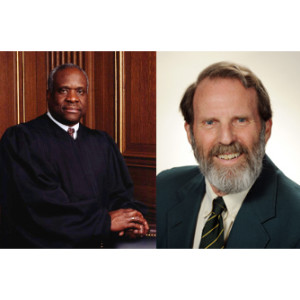Response by Professor Alan B. Morrison
Geo. Wash. L. Rev. Docket (Oct. Term 2014)
Reed v. Town of Gilbert, 575 U.S. ___ (2015).
Docket No. 13-502; argued January 12, 2015; June 18, 2015
Slip Opinion | SCOTUSblog
Like many localities, the Town of Gilbert, which lies about 18 miles southeast of Phoenix, Arizona, concluded that a proliferation of road signs impairs the beauty of the town and may create threats to traffic safety. The problem arose when the Town based the number, size, and duration of such signs on the message that the sign conveyed. In a 9-0 decision with three concurring opinions, the Court held that such distinctions could not stand under the First Amendment. Before turning to the dueling rationales, it is essential to examine the three categories in the Town’s Sign Code that are relevant to the Court’s decision.
First are “Ideological Signs”—the Town’s label, not mine—which are those “communicating a message or ideas for noncommercial purposes” and which do not fall into several other categories. They are treated most favorably, can be up to 20 square feet in area, can be erected in all parts of the Town, and have no time limits.
The next group covers “Political” signs, which are those “designed to influence the outcome of an election.” They must be no larger than 16 square feet on residential property, but can be up to 32 square feet on other properties. They can go up 60 days before a primary election, but only 15 days before a general election. There is no stated take-down time.
The final group, and the one in which the plaintiff fell, covers “Temporary Directional Signs Relating to a Qualifying Event” which includes those events put on by religious, charitable, and other similar nonprofit organizations. Their purpose is to announce the event and point interested persons in the right direction. Those signs can be no larger than 6 square feet, may be placed only on private property or on a public right of way, and they can be displayed only for 12 hours before and 1 hour after the event. Pastor Reed needed to use those signs to advertise his church services, which moved among various places because his church did not have its own building. His members would put out the signs early in the day on Saturday and take them down after noon on Sunday. He received a citation for exceeding permissible hours and also for not stating the time of the event on the signs. When he could not work out an accommodation, he filed suit alleging that the sign rules violated the First Amendment and the Court unanimously agreed.
Much of the difference among the justices was about the impact that the nature of the content of the three categories of signs should have on the legal rules applicable to the case, even though everyone agreed that the differing treatment could not be sustained based on the justifications offered by the Town for its sign regulations. As Justice Thomas put it for the majority, given the justifications of “aesthetic appeal and traffic safety,” the “distinctions fall as hopelessly underinclusive.”1 The signs that Pastor Reed wanted to use were “no greater an eyesore” than ideological or political signs, yet the rules strictly limit “the number, size, and duration of smaller directional ones.”2 Similarly, on threats to traffic safety, “[i]f anything, a sharply worded ideological sign seems more likely to distract a driver than a sign directing the public to a nearby church meeting.”3 With those conclusions, as Justice Kagan put it in her concurrence, the Town’s defense of its distinctions among different kinds of signs and others does not pass any level of scrutiny “or even the laugh test.”4 The disagreement among the justices was not over the result, but over the meaning and the consequences of concluding the distinctions here were “content-based.”
The majority opinion of Justice Thomas was joined by the Chief Justice, and Justices Scalia, Kennedy, Alito, and Sotomayor. However, Justices Kennedy and Sotomayor joined a separate concurrence by Justice Alito suggesting a number of kinds of signage laws, with distinctions that they conclude would not be barred by this decision, an enumeration that would seem unnecessary unless they had some concern about the breadth of the majority’s reliance on what it saw as content-based distinctions. Justice Breyer, in addition to joining (with Justice Ginsburg) Justice Kagan’s concurrence, also expressed concern about the majority’s use of categories to decide these cases. He would focus on what he called “content discrimination” to help decide the First Amendment questions when the line is unclear between subject matter and viewpoint as the basis for the law. He also objected to the strong presumption of unconstitutionality that he saw in the majority opinion.
No one disagrees that the First Amendment should be at its most vigilant when government favors one viewpoint over another, but that is not what the Town was doing here. On the other end, the Court has different rules that could be described as “content-based” for pornography, libelous statements, commercial speech, and various forms of election-related activity, including spending to speak and asking for political contributions, including this term by a candidate for a judgeship.5 No one can tell whether those special rules apply without knowing what the content of the speech is, and so saying that a rule is “content-based” is much too broad a brush with which to decide cases. As these conflicting opinions demonstrate, any attempt to define and explain the meaning of “content-based” rules, applicable to all cases, is likely to fail, either by sweeping too broadly (and denying governments the ability to make appropriate context-particular distinctions) or by looking only to the end goals of the legislation (as the Town and lower courts did here), thereby failing to recognize that the distinctions that were made were based on the message that was being conveyed—ideology, politics or directions. The Town may have made its different rules because of what it saw as the importance of the speech being disseminated, but because that assessment had nothing to do with the reasons for having the signage rule in the first place, its distinctions could not stand.
As Justice Kagan said in concluding her concurrence: “Because I see no reason why such an easy case calls for us to cast a constitutional pall on reasonable regulations quite unlike the law before us, I concur only in the judgment.”6 The debate over whether a law is content based and what that should mean is almost certainly not going to be settled by Reed, nor should it. Whether Justice Thomas’s opinion in its broadest reading will be followed also remains to be seen.
1. Reed v. Town of Gilbert, No. 13-502, slip op. at 15 (U.S. June 18, 2015) (majority opinion).
2. Id. at 15 (majority opinion).
3. Id. at 15 (majority opinion).
4. Id. at 6 (Kagan, J., concurring in the judgment).
5. Williams-Yulee v. Florida Bar, 135 S. Ct. 1656 (2015).
6. Reed, slip op. at 7 (Kagan, J., concurring in the judgment).
Recommended Citation
Alan B. Morrison, Response, Reed v. Town of Gilbert, Geo. Wash. L. Rev. Docket (June 19, 2015), http://www.gwlr.org/reed-v-town-of-gilbert/.



